ISSN ONLINE(2278-8875) PRINT (2320-3765)
ISSN ONLINE(2278-8875) PRINT (2320-3765)
| Dr. J. Abdul Jaleel, Nazar. A, Omega A R Dept. of Electrical and electronics Engineering, TKM College of Engineering, Kollam, Kerala, India. |
| Related article at Pubmed, Scholar Google |
Visit for more related articles at International Journal of Advanced Research in Electrical, Electronics and Instrumentation Engineering
Model of a solar cell and solar module is built in the LabVIEW software. Solar cell model is in single diode model and it is solved by familiar Newton Raphson method. IV characteristics and PV characteristics are simulated in LabVIEW and it verified at different temperature and irradiance conditions. Maximum power point tracking is incorporated in the simulation of PV module and the Maximum power point, voltage and current at this maximum power point were simulated at standard conditions and verified the result. The simulation system used for the analysis of solar photovoltaic module at different temperature value, solar irradiation value, series resistance Rs and shunt resistance Rsh . Behavior of the solar module in different diode ideality factor also analyzed. This model can be used for analysis of PV characteristics and for simulation with Maximum Power Point Tracking Algorithm(MPPT) algorithms.
Keywords |
| PVcell, PV module ,Maximum power point tracking, LabVIEW,Newton Raphson Method. |
INTRODUCTION |
| Energy is required for the large number of thing from home to cars to electronics. The traditional energy used for these purpose are coal natural gas, nuclear energy ,oil etc. Due to the crisis of traditional energy sources we need to find out the other source of energy. Solar energy is a good option and the electricity produced is clean and silent. They are long lasting and having little maintenance due to the absence of any moving part. The major disadvantages is their limited efficiency levels ;compared to other renewable energy sources. The output of solar cell is greatly depend on the weather conditions and fluctuating in nature. So we need to capture the maximum power from the solar panel. DC-DC converter based maximum power point tracking [2]is used for this purpose .For the study of this kind we need the model of a solar cell or module to check the performance of MPPT going to implement. Not only the MPPT system but also the device going to connect to the PV system need the model of a solar cell and the panel and it is important in designing the storage batteries stand alone PV system, grid connected system etc. LabVIEW (Laboratory Virtual Instrumentation Engineering Workbench ) is a good simulation as well as automation software , therefore the PV cell and module model in LabVIEW is very important. This paper is organized as follow: Section I gives the introduction of PV technology and the importance of mathematical simulation model in LabVIEW. Section II is helpful to understand the model of solar cell and related equations in developing the simulation on LabVIEW. In section III model of solar module is designed with the help of solar cell mathematical model and the section IV give Newton Raphson method for solving the nonlinear current voltage equation. Section VI show the simulated result of solar module and at last section VII concludes the paper and followed by the references. |
MODEL OF A SOLAR CELL |
| Photovoltaic cell consist of PN junction that when exposed to light releases electrons. The solar cell can be modeled as a current source parallel with a forward biased diode. The diode current Id is varies with the junction voltage Vd and the cell reverse saturation current Io. Most popular method of modeling solar cell is the single diode model that is shown in Fig.1[5]-[9] . In practical , solar cell is not ideal diode so there is some losses .In real cells, the effect is degraded by the presence of series resistance Rs and parallel resistance Rsh . Series resistance Rs is very small, which arises from the ohmic contact between metal and semiconductor internal resistance. But Shunt resistance Rsh is very large and represents the surface quality along the periphery. Leakage of current through the periphery represents Ish. Both the diode current Id and shunt current Ish given by the photocurrent Iph. In ideal case Rs is 0 and Rsh is ∞. The resultant current relationships are in the following equation, as dictated by Kirchhoff’s Current Law [1] |
| The current being sent through a diode is a |
 |
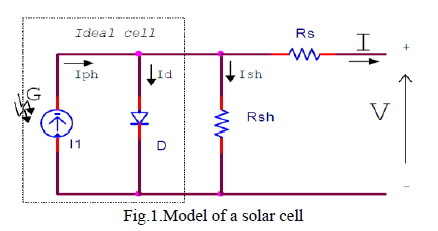 |
 |
| When the terminal of solar cell are open circuited the photo current generated by the current source is fully flow through the diode and Rsh . So maximum voltage Voc is produced across the terminal. When considering the case that the terminal of the photovoltaic cell are short circuited the photocurrent Iph is flow through the short circuited terminal. So the voltage across the terminal become zero and current I become Iph. So the short circuited current Isc is equal to Iph. Then we can write current I as, |
 |
| Isc is depend on weather conditions-ambient temperature |
| Ta and irradiation G . |
 |
| Tr: Reference temperature in Kelvin, Tc :Cell temperature in Kelvin, Iscr; Short circuit current at reference temperature Tr, Ki; Temperature coefficient of the short circuit current G:solar irradiation in wattm2 The cell temperature is the function of ambient temperature Ta and irradiation G |
 |
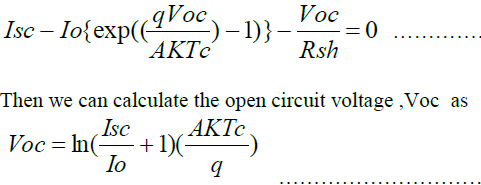 |
MODEL OF A SOLAR MODULE |
| A PV array is a group of several PV cells which are electrically connected in series and parallel circuits to generate the required current and voltage. The equivalent circuit for the solar module arranged in NP parallel and NS series cells.[6] is shown in Fig.2. If the cells are connected in parallel, then the total voltage of all cells is the same as that of one cell but the total current is the sum of the current values of the single cells. Since the current of a single cell can amount to more than 3 amp. and the voltage is less than 0.7 Volts, the parallel connection is rarely applied. |
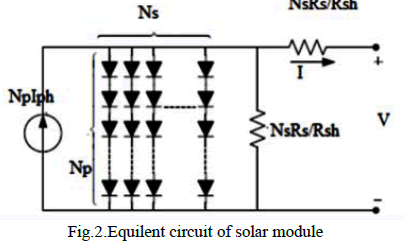 |
| . The terminal equation for the current and voltage of the array becomes as follows |
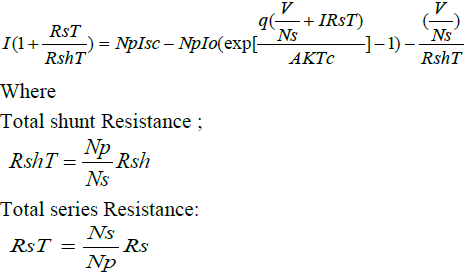 |
NEWTON RAPHSON ALGORITHM |
| Newton Raphson method is used for finding the root of a non linear function by successively better approximation[5]. If f(x) is a non linear function the first step is to find the derivative f’(x). Next step ischoose an initial x value xn.Each successive value of x closer to the value of x for f(x)=0,can be calculated by Eq.13 |
| Here we take the value current instead of x.Then the Eq.(13) become |
 |
| Then function of current can be expressed as |
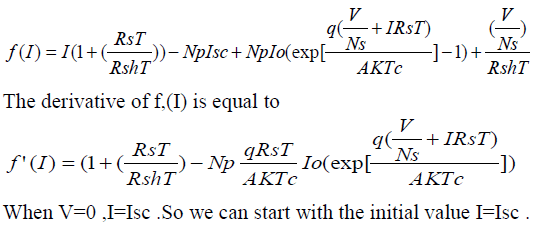 |
RESULTS |
A. PV module Simulation at standard condition: |
| The PV module simulation on LabVIEW is shown in Fig.3.and Fig.4. Fig.4 shows the block diagram [1][10] and Fig.5 shows frond panel. The frond panel comprise three graph of Power-Voltage , Current-Voltage and Maximum power point tracking (MPPT). The input to the simulation is given from the manufactures datasheets and input data are given in table.1. The other simulation parameters are set in the following values: Ta= -8.75 Degree Celsius, A=1.3(Polycrystalline solar cell), Rsh=500000Ω, Rs=.00005Ω. The simulation is done in standard condition to verify the working of LabVIEW PV model. The unknown parameters are calculated and power voltage and current voltage characteristics are simulated. The unknown parameters are saturation current at reference temperature Ior, saturation current Io and Short circuit current Isc at the given temperature are calculated from the input parameters. We can enter the atmospheric temperate the system calculate the cell temperature Tc. The simulated output values are shown in Table. 2. From the input parameters and calculated unknown parameters the simulating system draw the current voltage, Power voltage and Maximum power point tracking graph are drawn and shown in Fig.5 and Fig.6. |
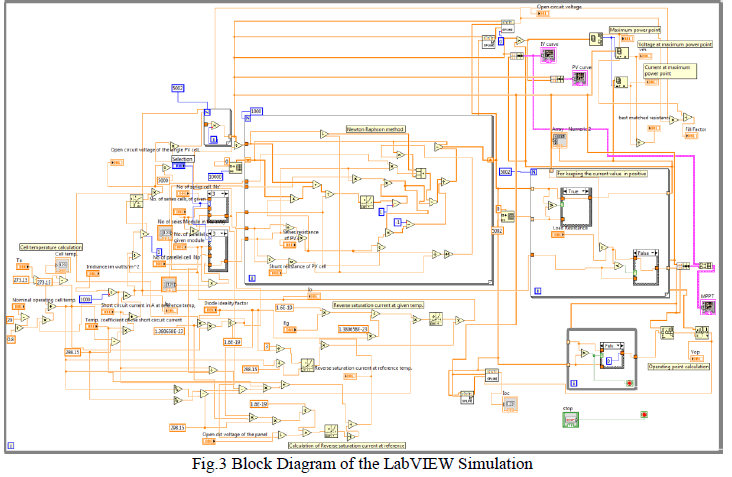 |
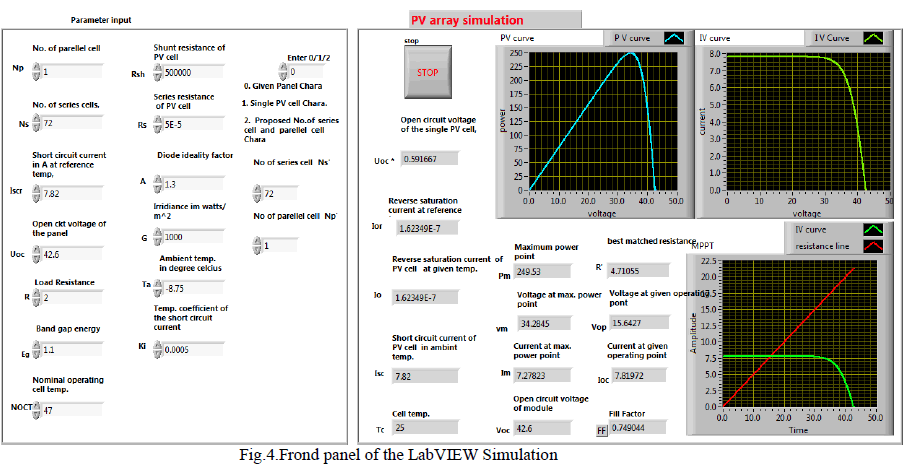 |
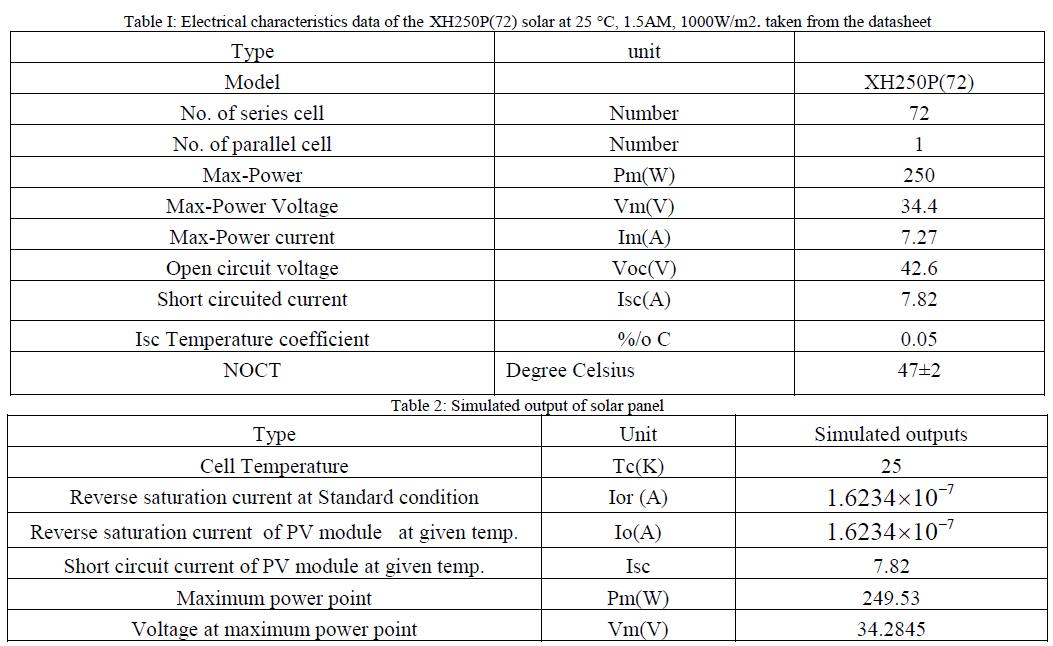 |
 |
 |
B. Maximum power point tracking Simulation: |
| The input parameters to the simulation system include the resistance load across the solar module and the value is 2Ω[1] . The intersection of IV curve and load line give the operating point. The Fig.7(a)shows the operating point at 15.6419V and 7.8198 A current. Simulated output of LabVIEW include the most suitable value of resistance as 4.71055Ω. When the load resistance across the solar module shifted to this most suitable resistance we can draw maximum power from a solar module[3].So the operating point shifted to new point of 34.2845V voltage and 7.27823 A current ;at this point we get maximum power. |
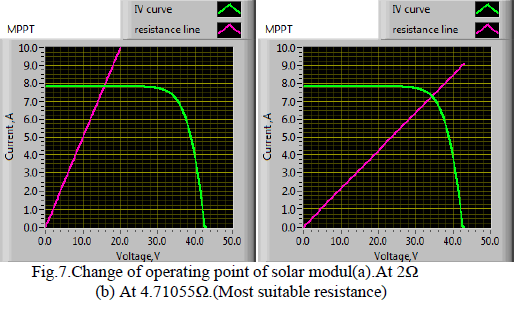 |
C. Variation of IV and PV curve at Various operating condition |
| In order to verify the model under different operating conditions, several tests have been performed at various temperature and solar irradiance values. Fig.8 shows I-V curves and P-V curve for various solar irradiance G varies from 200W/m2 to 1000W/m2 at standard cell temperature of 25 degree Celsius, while Fig. 9 illustrates I-V curves for different temperature values at solar irradiation of 1000 w/m2 .(T varies from 0°C to 85°C) |
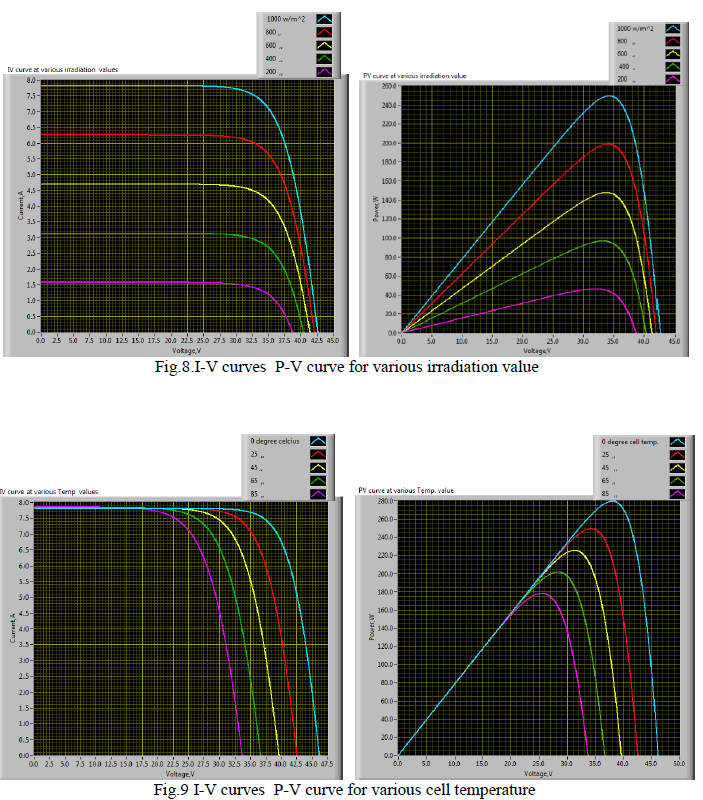 |
D. Variation of IV and PV curve at Various series resistance value Shunt resistance and Ideality factor |
| The internal factors like series resistance Rs, shunt resistance Rs and ideality factor A etc. having very good role in deciding the IV Curve and PV curve designing calculation. So we need to consider these factors for analyzing the the IV curve variation with respect to different values of Rs ,Rsh and A.Fig.10 shows the variation of IV and PV curve at different series resistance value. While fig 11.shows the variation with respect to different shunt resistance value. Diode ideality factor also an important factor in designing solar cell model .So the variation of the characteristics curve of solar module also done with respect to diode ideality factor and shown in Fig.12 |
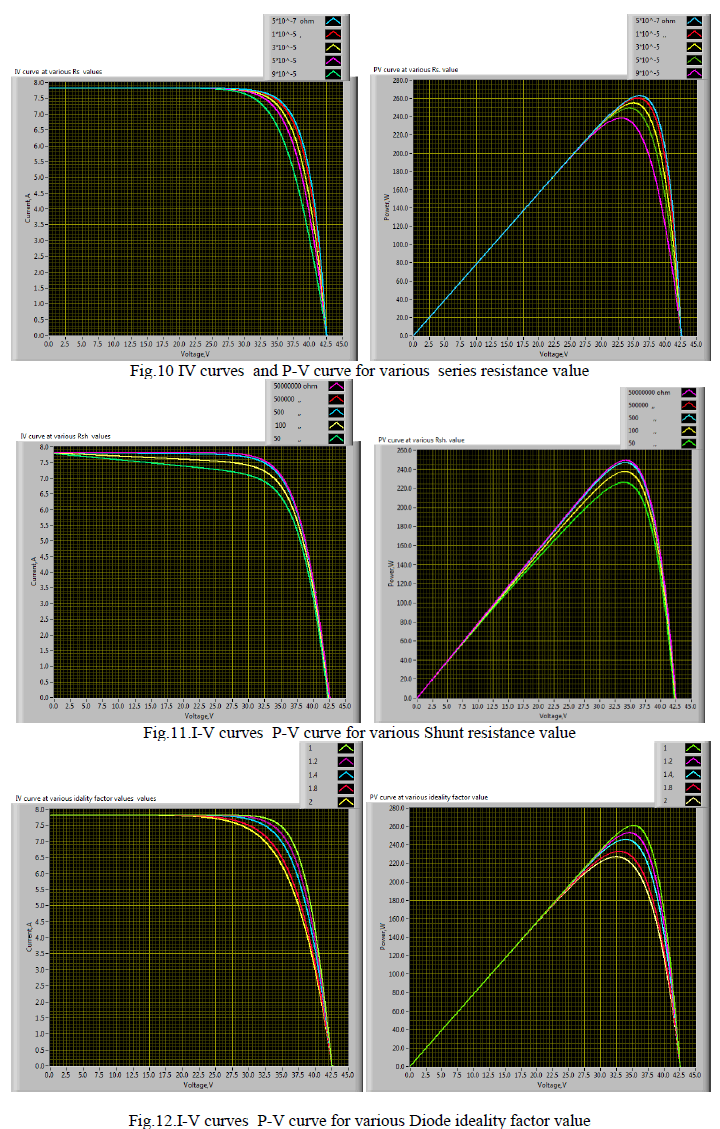 |
CONCLUSIONS |
| In this work, it is found that the current voltage relationship is non linear and there is a maximum power at a particular current and voltage .This maximum power is varying with respect to the atmospheric condition such as irradiation value of solar light ,atmospheric temperature and wind speed etc. In this analysis the of effect irradiation and atmospheric temperature on current - voltage characteristics and power- voltage characteristics are studied . When the irradiation level reduced the photo generated current reduced significantly. The open circuit voltage (Voc) is reduces also reduced but the effect is negligible. In decreasing atmospheric temperature value, at solar irradiation of 1000 w/m2 ,open circuit voltage is only decreased and the photo generated current remain constant . In effect the power is decreases with increase in temperature. When analyzing the effect of series resistance, we can see that the Isc and Voc remain constant but the maximum power point is varying. The series resistance influences the slope of the IV characteristics at the constant voltage region. At the same time parallel resistance Rsh influences the slope of the curve at the constant current region. The fill factor is affected by the change in parallel and series resistance. Ideality factor have a role in finding the maximum power point of solar cell at given condition. Ideality factor (A) having value between 1 and 2 and we can see that power peak of a PV Curve is affected by the ideality factor of the solar cell. This model can be used for analysis of PV characteristics and for simulation with MPPT algorithms. |
ACKNOWLEDGEMENT |
| The authors would like to thank the management, and Faculty Members, of Department of Electrical and Electronics Engineering, TKM College of Engineering, Kollam, for many insightful discussions and the facilities extended to us for completing the task. |
References |
|